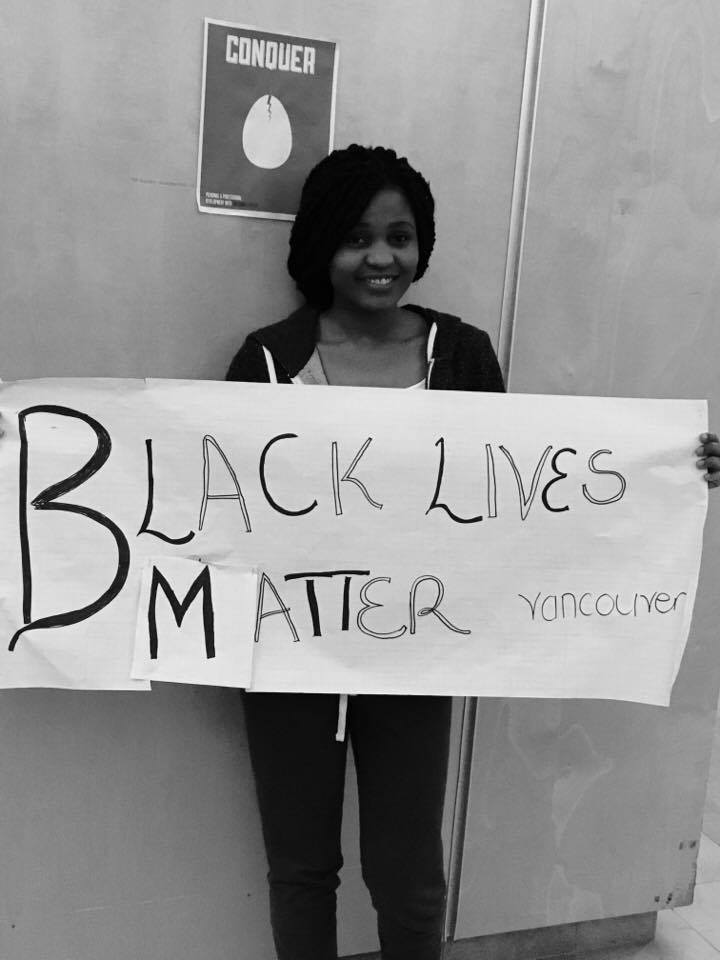Black Lives Matter
The picture above was taken at Place Vanier Residence, located on 1935 Lower Mall at the University of British Columbia. I want to bring your attention to the placard I am holding in this picture. Many of us are familiar with the hashtag #BlackLivesMatter, a grass root activist movement that began in the United States(US) in the summer of 2013 after the exoneration of George Zimmerman for fatally shooting the 17-year-old African-American Trayvon Martin in Florida.
Today, the hashtag has become symbolic in seeking justice and equality for the black population and other minority groups. When we say Black Lives Matter, we are broadening the conversation around state violence to include all of the ways in which Black people are intentionally left powerless at the hands of the state. (Russell Rickford 2015) It is viewed as a call to action, and a means to raise awareness and equality in many issues. The #BlackLivesMatter also exist in some parts of Canada, and only emerged in Vancouver in 2016.
Historically, the settlement of blacks in Canada can be traced back from their attempts to flee from the US, perceiving Canada as a safe space for the black population. Blacks were, in fact, much better off here in Canada compared to the US. However, it is also important that we recognize the segregation and absented history and good works of the blacks in Canada. Even now, the black population is invisible and remains “non-Canadian”. There is a direct cause – and – effect relationship with our collective present, as well as our collective future” (Mike barber 2013). In order to understand the presence that is the erasure and racism that a black Canadian faces, we need to understand the past and its causal relationship. It is of higher significance to look at what inspires the racism and exclusion in societies that blacks face in Canada and around the globe. It is important that we take note of how the past has shaped the lives of blacks and how this has led to the unending search of social equality. Very rarely do we ever see the words “Canada” and “black” side by side, as Katherine says … a nation that has and is still defining its history as Euro-white, or non- black.
The erasure of black history and presence can be understood using the Hogan Valley incidence in the 1960s, in which the blacks had the homes that they lived in demolished just because they were regarded as slums. The poverty, poor health conditions and deteriorated buildings that existed in Africville can be attributed to the fact that the City of Halifax collected taxes but did not provide the essential services such as sewers, paved roads and running water as according to the video watched in class. Katherine uses the term “absented presence” which was just right for the blacks who lived in Africville who were regarded as non-existing or invisible and therefore, unworthy of any services.
Throughout history, blacks have been considered as invisible, leaving them at the mercy of social vices such as sufferings at the hands of the police, institutional racism, and violence against women among other things. Black communities are non-Canadian, always other, always elsewhere, recent, unfamiliar, and impossible (McKittrick 2006). Historians of black Canada often begin their analyses by outlining the frustrating ways in which black history is hidden, eradicated, or under-explored; #BlackLivesMatter, which Garza has called a “love note” to the black communities, now serves as a shorthand for diverse organizing efforts to fight the silenced black body in Canada and the racism that comes with it. It is the most recognizable expression which symbolizes the black outrage against police brutality and racism in all aspects.
The Black Lives Matter in Vancouver aims to find ways to bring to light how women also experience violence from the police and other institutions. Despite the efforts that blacks are putting into seeking attention and visibility in Canada, their erasure remains part of the history, and sadly, part of the present, as recently, the Vancouver organizers of the Women’s march did not contact or include the Black Lives Matter to participate as one body.
Conclusively, we see how in multiple instances the ideology of black erasure in Canada is emphasized. This silencing of marginalized groups is what leads to the continuation of the protestations done by Black Lives Matter around the globe.
References
Mike Barber…(2013) http://www.blackacademypress.com/2011/01/invisiblehistoryof
slaverycanada/
McKittrick, K..Demonic Grounds: Black Women And The Cartographies Of Struggle. Minneapolis: University of Minnesota Press, 2006. Project MUSE,
Russell Rickford: (08-2015) New Labor Forum, Vol 25, Issue 1, pp. 34 – 42 doi:10.1177/1095796015620171
